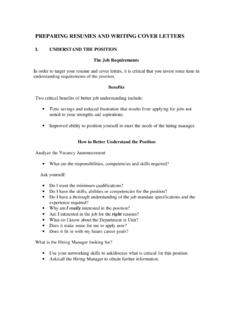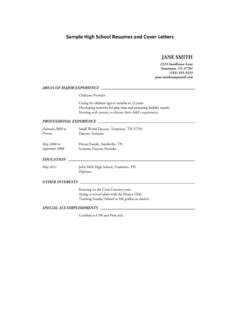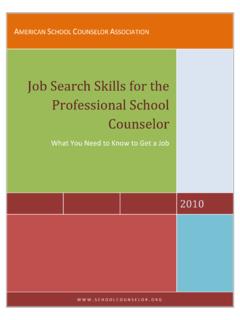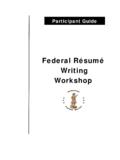Transcription of Resume & Cover Letter Guide - unice.fr
1 Career ServicesCareer ServicesCareer ServicesCareer Services Center for Experiential LearningCenter for Experiential LearningCenter for Experiential LearningCenter for Experiential Learning Keuka CollegeKeuka CollegeKeuka CollegeKeuka College Phone: (315) 279 Phone: (315) 279 Phone: (315) 279 Phone: (315) 279----5274527452745274 Fax: (315) 279 Fax: (315) 279 Fax: (315) 279 Fax: (315) 279----5329532953295329 Resume & Cover Letter Guide Creating a R sum Think of your r sum as a marketing tool. It is essential to obtain exciting internships, volunteer positions, and employment opportunities. A r sum provides employers with an introduction to you, especially your skills and experience. Your r sum should provide the employer with a brief overview of your educational and career experiences in a concise and easy to read manner.
2 Presentation and the type of information included can often determine whether or not you will be offered an interview. An employer will use your r sum to determine if your education, experience, and skills match their job specifications. Types of R sum s The most traditional format is the Chronological R sum which is structured according to experience; positions and activities are listed starting from most recent and moving backward in time. Chronological r sum s are most often used by individuals seeking employment in their current field, or in one that is similar. Traditional recent college graduates typically use this format. The Functional R sum emphasizes a person s skills and abilities rather than work history. A functional Resume is particularly useful for people who: Have gaps in their work history.
3 Have a mixed bag work history; no clear thread unites positions held. Are reentering the workforce. Have frequently changed jobs. Are looking to transition into new careers. Have job titles that do not clearly reflect the level of skills you used. Don t exactly fit the mold of what recruiters are looking for in the positions they are filling. The Basic Ingredients: Use the worksheet provided in this Guide to get your education, experience, and skills in order. Use action verbs to explain your skills and jobs. These sentences can then be incorporated into the body of the actual r sum as brief bulleted descriptions. Organize your r sum so that your key experiences and accomplishments will be presented early and effectively. Use headings to put your achievements into categories. Curriculum Vitae A curriculum vitae- often called a CV or vita- is similar to a r sum , but is longer and provides a more comprehensive portrayal of your skills, experiences, and education.
4 Vitas are used primarily by students seeking academic opportunities such as positions in teaching or research, and fellowships or grants. There is no set format for a CV. To view samples, visit the Quintessential Careers website: Vitas may include all or some of the following: Personal/contact information Academic background Professional licenses or certifications Teaching experience Technical skills Related experience Professional or academic honors Professional development Research interests and activities Service positions held Affiliations/memberships Foreign languages References R sum Writing Tips Use standard Resume paper (preferably white and avoid flashy colors). Good resumes also have a combination of text and white space. Make your Resume easy to read and present the most relevant information early.
5 Your name needs to stand out so use a large font size (usually 20+ depending on the font). Also, you can use a font different from the text of your Resume for your name to make it more noticeable. Include both your home and college address on your Resume . You want an employer to be able to contact you no matter where you are. Remember to use appropriate e-mail addresses (like your school e-mail or Begin with an objective that states what you are aiming for (short phrase, not a complete sentence). All section headings should stand out (bolded, larger font, underlined, etc.) to make the Resume easy to navigate. Consistency is very important! Make sure your headings, bullets, margins, spacing, font, etc. are constant throughout your Resume . Remember that wording is important. Use action verbs and focus on your accomplishments.)
6 There is an action verb list on page four. For current positions use verbs in the present tense. For former positions, use past tense verbs. Usually do not include your GPA if it is below You can be creative with your section headings. Here are some examples: Career-Related Experience, Volunteer Experience, Leadership and Involvement, Clubs and Organizations, Computer Skills, Honors and Scholarships, etc. Make them fit what you want to portray to the employer. Each heading should have at least three (and no more than six or seven) bullets. Do not use sentences on a Resume . You want it to be short and sweet easy for the employer to read. Explain what it was that you actually did briefly using bullets and precise wording. Do not include high school information (jobs, awards, sports, education, etc.)
7 Unless an award, a job, or your actual high school relates to the position to which you are applying. An employer might not know what certain clubs or organizations are, so be sure to clarify. Do not use abbreviations unless you define them. Relevant Coursework is an optional listing use it only if the courses really are relevant to the job you are applying for and you have a few to list (three to six), not just one or two. References available upon request . Including this statement is a matter of preference. Many people include it, but it is not necessary since most employers assume that references are available upon request. Proofread! Proofread! Proofread! Have at least two other people review your Resume . Never send a Resume without a Cover Letter , even if the employer does not request a Cover Letter .
8 You can also include your list of references as well. Make sure you use the same header you used on your Resume for your references list. If you need two pages to fit in all of your information, use all or part of your heading on the second page, do not print on the back side, be sure to fill the entire second page, and use a paperclip instead of stapling the pages. If an employer requests that you send your Resume electronically, save it as a PDF so that no formatting issues occur when the employer opens your Resume on his or her computer. Remember that there is no prescribed set of categories, order of information, or rigid framework into which your background must fit. Create your own r sum ; don t use someone else s generic format. Make your r sum a reflection of the individual you. Sample Chronological R sum Format NAME Present address: Permanent address: City, State, Zip City, State, Zip Phone (include area code) E-mail Phone (include area code) OBJECTIVE An objective is optional, but when well written can help focus your interests, experiences, and goals.
9 Be specific when applying for a particular job, and general when posting your Resume on a job-posting Web site. EDUCATION List your degree, major(s), institution (including its city and state), and date of graduation or expected graduation, as well as any minors and/or concentrations. You may also want to include your GPA (if above a ) if appropriate. Point out areas of specialization in academic work and international education to compliment your experience. To get the maximum mileage out of your education you can describe honors, awards, special projects, and coursework, or to highlight these areas more, you can put them under separate headings. You can also choose your own section headings; just make sure they are simple and concise. EXPERIENCE Include your experience from the last four years; you can go back further if the experience is very relevant.
10 For each entry, include your position title, name of the organization, the city and state, and a bulleted description of your duties be specific about your skills. Start each of these bullet statements with an action verb (see Action Verb List below). Include the variety of assignments, amount of responsibility, number of people supervised, special accomplishments, and dates of affiliation. Employers are seeking people who are creative, take responsibility, and can adapt quickly to new situations. Experience includes paid work, unpaid work, Field Periods, volunteer work, community service, part-time and temporary positions, internships, unstructured work, self employment, odd jobs, and tutoring. ACTIVITIES/LEADERSHIP Position title, name of organization, brief description of what you did (optional), and dates.






